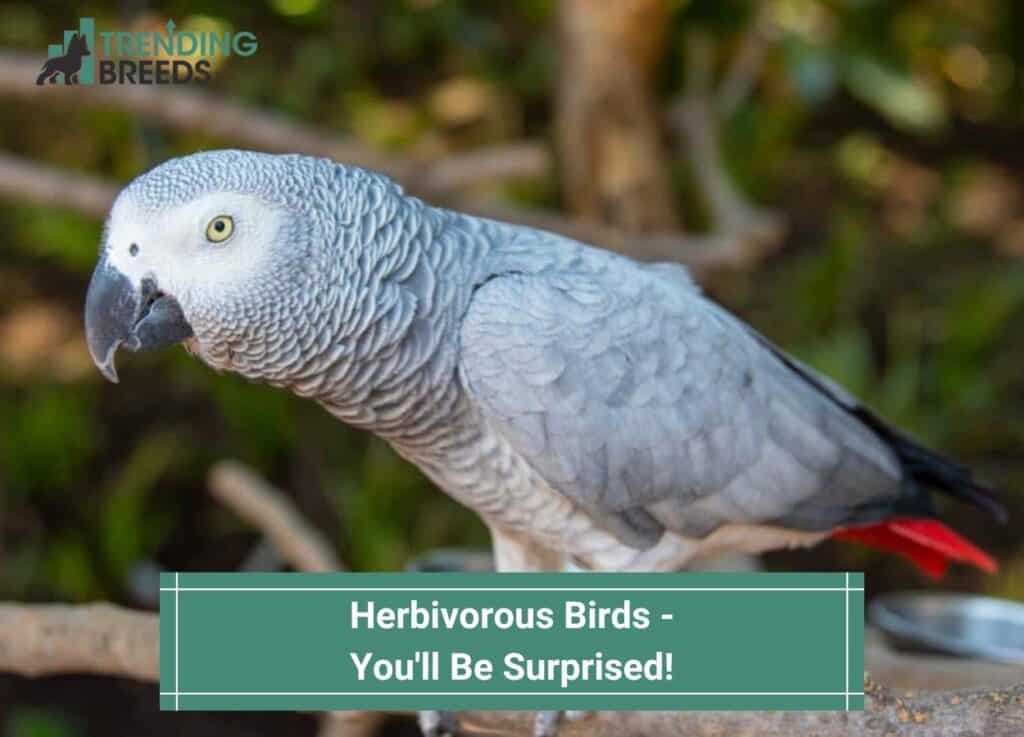
There are many bird species out there. Some are omnivorous, some are carnivorous, but some are herbivorous birds.
These birds only eat plants or seeds and have no problems passing up a nice, juicy earthworm hiding in the grass.
Before you scroll further down this guide, check out these other bird-related articles: Best Bird Rescues in Australia and Why Do Birds Kiss?
Table of Contents
What Is a Herbivore?

A herbivorous animal is a vegetarian. They rely exclusively on plants for nutrition. Generally speaking, herbivores are very selective about what they eat.
The type of plant they eat determines the classification of these creatures. Fructivorous only consume fruit. Leaves are the primary food source for folivorous birds.
Nectivorous birds feed on nectar. Polynivorous birds prefer pollen over seeds, while granivorous birds eat seeds.
Which Birds Are Herbivores?

Here’s some of the most common birds that prefer plants to eat.
1. Finches

A finch is a type of songbird found everywhere except in Australia. In addition to living in various habitats, they have a careful method with which they construct their nests, which look like baskets.
The triangular shape of their beak indicates what they eat. Due to their herbivorous nature, they consume different seeds and fruits.
Most of their food is seeds, but they also eat vegetables and fruit. Wild finches eat different plants and seeds when they are out in the open.
Eating organic leafy green vegetables and different plants and seeds throughout the year will benefit their health.
2. Orioles

The oriole is a brightly colored bird found in North America and parts of South America.
They mostly consume plants as their main diet but also fruits, nectars, and other plant materials. For most of their lives, Orioles live in forests and wooded areas.
Orioles migrate between Central America, the Caribbean, and parts of South America during winter to stay warm.
Their beautiful songs sound throughout the year, making them popular birds. They usually lay four to five eggs in nests made of twigs and other materials.
3. Nene Goose

Plant-eating birds like the nene goose are closely related to Canadian geese. The Hawaiian Islands are the home of this species. The birds are brown, gray, and black, with black eyes, legs, and feet.
Interestingly, these avians can walk on rough lava plains thanks to their strong legs. Hawaii’s grasses make up most of the baby goose’s diet, which is considered quite nutritious.
4. Hoatzins
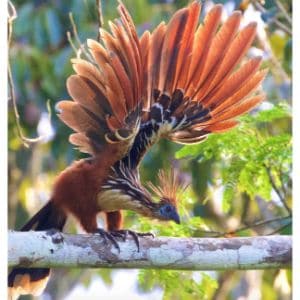
A hoatzin is a tropical bird found in South America that is the size of a chicken (but slightly slender).
The chicks hatch with two large claws on each digit of the wings that disappear as the chicks grow, and have a prolonged, rufous crest and spiky tails.
Hoatzins are exclusively folivores, or herbivores, that eat mostly leaves, flowers, and fruit.
Birds eat more than fifty types of plants, and mainly leaves are eaten, with flowers and fruits making up only 10 percent of their diet.
Additionally, birds have a weird digestive system, which ferments their food, just like cattle. In addition to warding off predators, including humans, this digestive system emits a stinky odor.
5. Doves
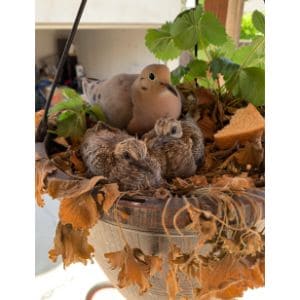
It’s interesting to note that doves are sometimes called birds of peace, but they are not very peaceful at all! Watching them wing-slap each other after you put out seed for them is funny.
Doves are most commonly found in far-flung corners of our planet, except Antarctica. Doves are generally herbivorous animals. It is not unusual for birders in the garden to see doves gobbling up seed.
Their diets vary depending on species, but they mainly consume plant matter. Different areas of the world have different habits of eating fruits and berries, while some doves prefer seeds and grains.
6. Cockatoos
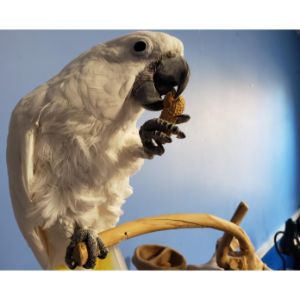
It is a white bird found in Australia and New Guinea, and it is large and has sulfur-crested feathers.
Seeds, nuts, and fruit are their primary diets, but other plant materials will also be consumed. You would normally find cockatoos in rainforests and wooded areas. Sulfur-crested cockatoos live in forests.
Cockatoos are known as the largest bird in the parrot family. They can get up to two pounds and have a big wingspan. Yellow beaks and bright white plumage distinguish the sulfur-crested cockatoo from other birds.
They are also known for being smart and funny, so they are popular pets for many.
7. Quails

Pheasants and quails share the same family of game birds; both primarily eat grains and seeds.
It is still true that they will not turn a feathered head away from insect-like many herbivorous birds. In between grasslands, bobwhite quail build nests. Nests are made from dead plants and twigs.
Quail are found in 130 different species, and they feed primarily on plants that have gone to seed.
Quails have short necks and plump bodies, which means they don’t fly very well. Most of the time they are foraging on the ground.
8. Hummingbirds

There are many varieties of hummingbirds around the world, but these brightly colored birds are among the smallest.
This bird eats mostly nectar from flowers, insects, and other creatures. Most people see hummingbirds buzzing around flowers in their gardens, but they can also live in deserts.
9. Oilbirds

Amazon rainforest oilbirds are nocturnal birds. Fruit is usually the main source of food for these birds.
A cave or other dark place is the ideal habitat for oilbirds. Due to their large eyes, they can see well in low light conditions, so they can fly in the dark.
10. Parrots

Everyone loves a colorful parrot and there’s a lot of different kinds. Worldwide, 398 species have been identified.
Most of them live in the wild, but many of them, including Amazon and macaw parrots, are kept as pets, especially because of their color, personalities, and intelligence.
Seeds are the preferred food of parrots, with plants making up most of their diet. Their short, curved bills have evolved to be powerful and short for breaking open seeds.
In the wild and captivity, parrots eat almost exclusively seeds, although they also consume nuts, buds, flowers, and fruits.
Rarely, birds will accept insects, although the amounts aren’t significant.
What Birds Are Omnivores?

Many different bird species are omnivores and will eat whatever they can find. Food sources near and in their habitats determine the variety of diets of these birds.
Food sources within omnivorous birds’ ranges and habitats affect their diet greatly, as well. Seeds, grasses, fruits, nuts, grains, nectar, pollen, and buds are some plant foods eaten by omnivorous birds.
Among the types of animals that omnivorous birds eat are bugs, reptiles, decaying animal remains, small mammals, eggs, amphibians, and just about anything else they can find.
A bird doesn’t have to consume every type of food to be considered omnivorous. However, animals and plants are essential to a healthy diet.
In their hatchling and juvenile years, birds eat very different diets, so it is not feasible to categorize them until adulthood.
The reason is that young birds need nutrients and protein to grow and develop, which are abundant in food rich in these nutrients.
Robin
Robins like to eat a diet of different plants and animals, making them omnivores. Even though they hunt small animals occasionally, they eat primarily invertebrates as they are easier to catch.
They catch earthworms, grasshoppers, snails, flies, crickets, and other types of prey. They also eat seeds, nuts, berries, and fruits as an important part of their diet.
They usually hunt prey in the morning and forage when it gets late or dark out.
Woodpeckers

In addition to eating plants, woodpeckers also feed on animals. Its North American counterparts, ivory-billed woodpeckers and pileated woodpeckers, are omnivores and carnivores, respectively.
The spring season is more insect-free, so woodpeckers get their protein from tree sap instead of insects.
However, some woodpecker species rely on tree sap throughout the year, such as red-naped sapsuckers and yellow-bellied sapsuckers.
In addition to apples, grapes, cherries, blackberries, oranges, and blueberries, many woodpecker species also enjoy eating berries of all kinds.
Magpies
Invertebrates, plants, animals, and invertebrates are all food sources for magpies, which are omnivorous scavengers.
A magpie feeds on worms, caterpillars, beetles, spiders, and flies as arthropods, invertebrates, and insects. As well as birds and their eggs, they eat lizards, small mammals, and other small animals.
Pheasants

Pheasants feed almost exclusively on food foraged from the ground, making them omnivores.
In addition to berries, seeds, nuts, grains, shoots, and roots, as well as insects and worms, pheasants consume a variety of food. In addition to hunting rodents and small lizards, some pheasants also hunt small animals.
Which Birds Are Carnivores?

These birds prefer to eat meat and are predators. Unlike omnivores that each meat and plants, these birds don’t eat plants unless there is no meat available, and some will still ignore plants in search of meat.
Chickadees
There are black-capped chickadees throughout North America. The range covers the southern coast of Canada, the Gulf of Mexico, and the eastern and western coasts of the United States.
In addition to nesting in trees, cliffs, or abandoned buildings, the Chickadee is a migratory bird. Insects are the main food sources for the chickadee, but small fruits and berries are also consumed.
Carrion Crows
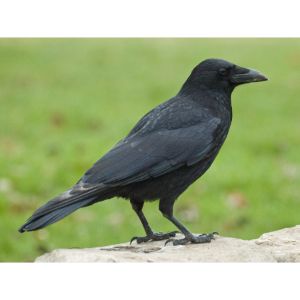
Like vultures, carrion crows are scavengers, but unlike them, they tend to live near humans more often than in the wild. Humans dispose of biomass in almost all forms, including carrion crows.
Although they feed primarily on dead animals, they eat live animals like worms. As well as catching larger prey, these birds often bully other carnivores into giving up their kills by ganging up together.
White-Breasted Nuthatch
Nuthatch species which are common in the eastern United States are the White-breasted Nuthatch.
It is found in New England, the Florida Keys, the southwest, Oklahoma, and the north and central province of Manitoba.
Nuthatch generally inhabits forests but can also be found in orchards and open woodland. As well as insects, nuts, seeds, and fruit, it feeds on other plants.
Scarlet Tanager

Throughout North America, the Scarlet Tanager inhabits a variety of habitats with its crimson-red feathers and black wings.
Common habitats include forests and edge habitats, as well as urban areas.
However, they are more commonly seen in forests than in urban settings. Insects constitute most of the Scarlet Tanagers’ diet but consume small birds and animals.
In addition to building their nests near water, they have also been known to build nests on high trees.
Broad-Winged Hawk
An American and Canadian Broad-winged Hawk can be found all over the country. An estimated 1,000,000 hawks live in North America, making it the most common hawk.
Broad-winged Hawks are raptors that primarily scavenge carrion. Rodents, chipmunks, shrews and lizards are its primary sources of food, along with snakes, crabs, snakes, and insects.
Scops Owl

Scops owls are large ones found throughout much of North America. You can find them in open areas such as prairies, meadows, and woodlands.
It’s easy to identify them because of their obvious look. In addition to hunting at night, scops owls will also hunt during the day.
Insects, birds, reptiles, and amphibians are also some of the food sources for owls, which eat mainly small mammals.
American Kestrel
Most of North America’s fauna comprises American Kestrels, a small, falcon-like bird. Forests and farmlands are its preferred habitats, but it also inhabits urban areas occasionally.
Nesting can be found in trees or on the roofs of buildings in urban areas. It is a very common bird there. The diet of the American Kestrel consists largely of small birds and rodents, but insects are also consumed.
Frequently Asked Questions
What birds cannot be eaten?
The pitohui, the ifrita, and the rufous or little shrike thrush have toxins in their feathers, rendering them inedible.
What is the strongest bird?
The strongest bird is the Harpy eagle, which can carry monkeys that weigh up to 30 pounds.
Which is the longest-living bird on the earth?
The albatross currently has the record as the longest-living bird in the wild.
If you find this guide, “Herbivorous Birds – You’ll Be Surprised,” informative and helpful, you can check out these other animal-related articles from our team:
- Big Dogs That Are Good With Cats
- Cats With Big Noses You’ll Absolutely Love
- Interesting Blond Cat Breeds
You can learn more about birds by watching “5 INTERESTING FEATHER FACTS” down below:




